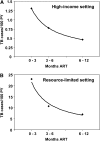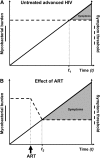Immune reconstitution and "unmasking" of tuberculosis during antiretroviral therapy
- PMID: 18202347
- PMCID: PMC2277208
- DOI: 10.1164/rccm.200709-1311PP
Immune reconstitution and "unmasking" of tuberculosis during antiretroviral therapy
Abstract
Tuberculosis (TB) is the most common opportunistic disease in HIV-infected patients during the initial months of antiretroviral therapy (ART) and presents a great challenge to ART programs in resource-limited settings. The mechanisms underlying development of TB in this period are complex. Some cases may represent progression of undiagnosed subclinical disease present before starting ART, emphasizing the importance of careful screening strategies for TB. It has been suggested that progression in such cases is due to immune reconstitution disease-a phenomenon in which dysregulated restoration of pathogen-specific immune responses triggers the presentation of subclinical disease. However, whereas some cases have exaggerated or overtly inflammatory manifestations consistent with existing case definitions for IRD, many others do not. Moreover, since ART-induced immune recovery is a time-dependent process, active TB may develop as a consequence of persisting immunodeficiency. All these mechanisms are likely to be important, representing a spectrum of complex interactions between mycobacterial burden and changing host immune response. We propose that the potential range of effects of ART includes (1) shortening of the time for subclinical TB to become symptomatic (a phenomenon often referred to as "unmasking"), (2) increased rapidity of initial onset of TB symptoms, and (3) heightened intensity of clinical manifestations. We suggest that the term "ART-associated TB" be used to refer collectively to all cases of TB presenting during ART and that "immune reconstitution disease" be used to refer to the subset of ART-associated TB cases in which the effect on disease severity results in exaggerated and overtly inflammatory disease.
Figures



References
-
- Palella FJ Jr, Delaney KM, Moorman AC, Loveless MO, Fuhrer J, Satten GA, Aschman DJ, Holmberg SD; HIV Outpatient Study Investigators. Declining morbidity and mortality among patients with advanced human immunodeficiency virus infection. N Engl J Med 1998;338:853–860. - PubMed
-
- Braitstein P, Brinkhof MW, Dabis F, Schechter M, Boulle A, Miotti P, Wood R, Laurent C, Sprinz E, Seyler C, et al. Mortality of HIV-1-infected patients in the first year of antiretroviral therapy: comparison between low-income and high-income countries. Lancet 2006;367:817–824. - PubMed
-
- Autran B, Carcelain G, Li TS, Blanc C, Mathez D, Tubiana R, Katlama C, Debre P, Leibowitch J. Positive effects of combined antiretroviral therapy on CD4+ T cell homeostasis and function in advanced HIV disease. Science 1997;277:112–116. - PubMed
-
- Battegay M, Nuesch R, Hirschel B, Kaufmann GR. Immunological recovery and antiretroviral therapy in HIV-1 infection. Lancet Infect Dis 2006;6:280–287. - PubMed
-
- Egger M, May M, Chene G, Phillips AN, Ledergerber B, Dabis F, Costagliola D, d'Arminio MA, de Wolf F, Reiss P, et al. Prognosis of HIV-1-infected patients starting highly active antiretroviral therapy: a collaborative analysis of prospective studies. Lancet 2002;360:119–129. - PubMed
Publication types
MeSH terms
Substances
Grants and funding
LinkOut - more resources
Full Text Sources
Medical

